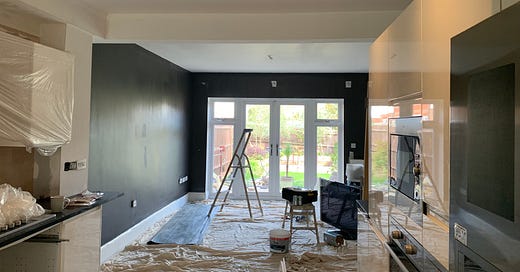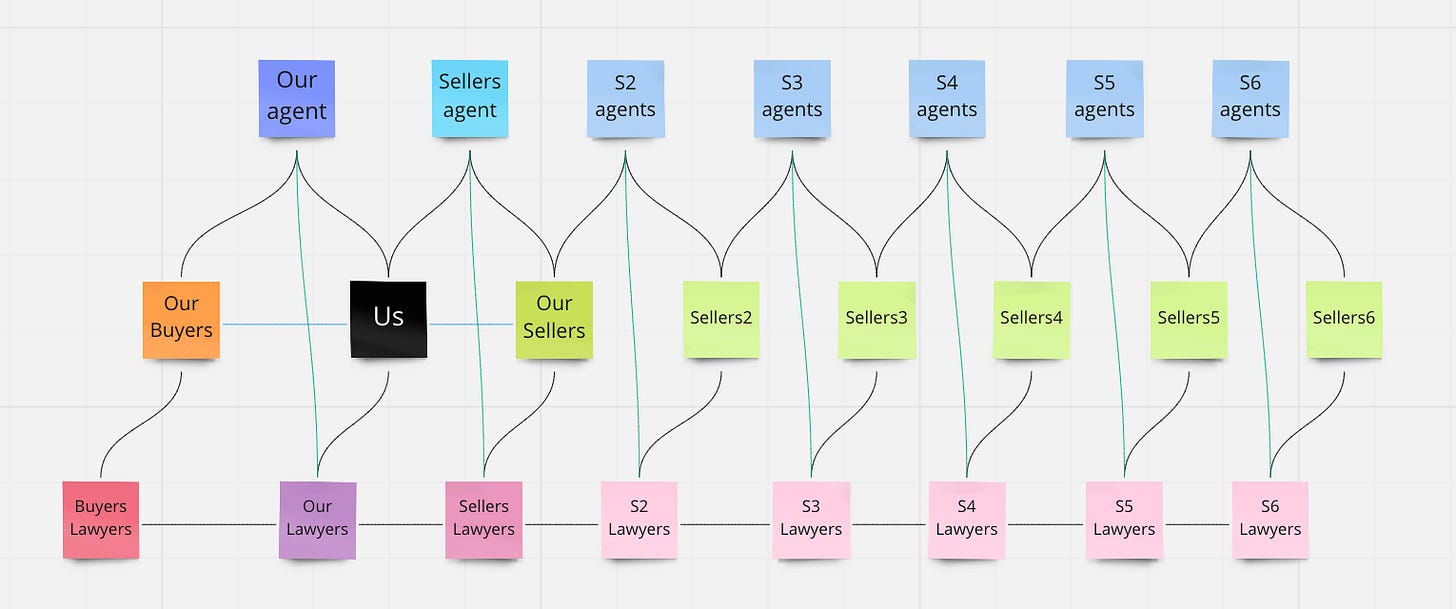IEX #165: Re-Imagining How We Buy & Sell Homes
Platformisation, Service Aggregation, & Blockchain based Identity Management can reinvent the home buying market.
I spent the last weekend shifting house. I feel like I'm still surrounded by boxes, and I wake up dreaming about packing and unpacking, but the truth is that some 36 hours of work has ensured that the packing, moving, and unpacking has been navigated despite the inclement weather. And though we still have painters and plumbers finishing their work, normalcy is within reach. But most of all, because this is in many ways the easiest part of the whole process. Yes it's back breaking physical work. But my story starts some 6 months ago...
6 months ago, we visited friends in St Albans and thought it would be a nice place to live in. Lo and behold, a very attractive property came up on the market within the week. We visited them on the Saturday, we were the first viewers, we made an offer at the asking price, the offer was accepted by the owners (our sellers), and by Monday, the house was off the market. We then had to turn our attention to selling our house, and our sellers had to find a house to live in.
This should basically involve 3 key players - our buyers, us, and our sellers.
Of course, there are agents for any sale, and there are lawyers required for buying and selling property. So then the picture looks more like this.
But if you know anything about how this works in the UK, you will know that property transactions often involve chains because of the way the movement of money and contract is managed. So our sellers need to find a house to buy, and their sellers need to buy, and so on, until you reach somebody who is either selling a second home or is moving out of the country, or for some reason doesn't need to buy a home after selling one. In our case this involved a chain of 8 sets of people, each with their agents and lawyers. Which means that the cast of characters looks something like this...
Note that the lines, which represent communication channels, means that we cannot officially talk to our buyers or sellers. All queries, discussions, negotiations need to be routed through the 2 sets of lawyers. The lawyers also speak with the respective agents for information exchange. Informally we may be talking with our sellers and buyers (we set up a WhatsApp group with our buyers to ease communications - hence the blue dotted line), for reasons that will become apparent.
The challenges: For simplicity, I'm clubbing a plethora of problems into 5 broad problem areas.
Information immaturity: there is a startling lack of information maturity in this entire process. The lawyer typically has to raise and address a number of queries - such as: ‘what planning permissions and structural changes has the house been subjected to in the past’. Or ‘what is the list of permanent furniture and fixtures that we have in the house’. Most of these questions are answered through a manual form or emails or at best individual online queries. In 2007, the government had put in place the creation of Home Information Packs but because of the teething troubles, and the fragility of the market, this was scrapped in 2010. A pity, because logically the information associated with a home should reside with the home, not in a dozen unconnected places, from where they have to be queried. Anything else is suboptimal. Even for the end user, there is very little by way of an accessible knowledge base. Nobody talks about bridge loans, for example, even though they exist.
Contract sequence: in the UK, the contract is signed only when the lawyers have satisfied themselves that all the necessary questions have been asked and suitably answered. It is therefore common for this phase to take 3 months or more. During that time, no party has any obligation to the deal and can walk away at any point with no obligation. Following the contract exchange as it is called, in a fortnight or so, you agree the date for contract completion - this is when the money changes hands, and also the keys are handed over. For us, the contract was signed in early September, and completion was in late September, despite our offer being accepted in March. This is also due to the problem of lock-step. Early on in the process, our buyers were also unable to find the right home for themselves, and we even recommended some properties to them!
Lockstep: Because of the constraints of the financial system, the contract completion needs to happen exactly on the same date for everybody in the chain, so that people can also move at the same time and nobody is left temporarily homeless. This problem tends to have levels of complexity correlated to some exponential power of the number of companies involved. For example very late in the game when our buyers were struggling to agree the completion date because they couldn't get movers for the given date, it meant impacting everybody on the chain. So we recommended movers to them, whom they were able to use.
Weakest link: The lockstep also means that everybody is dependent on the weakest link. If any one entity in this chain has a stumble, it impacts the entire chain. If any one of the lawyers misses a step or a query and has to complete it later, the delay impacts all players in the chain. And the opacity of the overall system means that it's hard for others to provide answers even if they have options to share. In the hours before the contract signing, we were passing on information to our buyers about how to set up the bank transfers so that it would not hold up the contract exchange.
Communication efficiency: In this very complex and sequential process, every question, when routed through 2 sets of lawyers will take much longer. And that's no reflection on the lawyers, who may be very efficient. A simple question such as "what date can we agree to for contract completion" has to be agreed through a series of bilateral discussions between pairs of lawyers. Our WhatsApp group with our buyers was very useful for questions such as “do you have a Sky dish installed?”, or “do you get foxes in the garden?” But formal communication was still legally routed.
What's the Solution?
This is an environment crying out for platformisation, blockchain, service aggregation.
First, we need the principle that information flows better when shared to everybody in a marketplace model than in a liner link-by-link model. So if seller6 in our chain is facing a delay because of a complication in their mortage, it can be published to everybody in the chain, rather than the current flow which is lawyer-to-lawyer, till it gets to us, by which time the problem may have vanished.
Second, we need to revisit the HIP (version 2.0) where any information that is connected with a house should be available easily based on a unique identity of the asset (house). 10 years is a long time in tech, and many of the problems of HIPs may be solvable at much lower cost now. So the relevant planning permissions, the floor plans, the architectural details, etc. should all be directly connected to the house so that if the home-owner gives permission to anybody, they can easily access all this related information.
Third, we need all of this to be done in a decentralised and immutable way - enter blockchain. These are all large, complex, high value transactions with low demand for speed, so they are the right environment for blockchain based options. Blockchain has already been used for land registry in some parts of the world, and any work done on a house, which has been supported by an approved planning permission can be a part of the blockchain. Likewise information about previous owners, land registry, and much more. Our house is a relatively new build and a part of our process was held up because of the slow rate of response from the construction company about some details.
Last, this can be extended as a services marketplace. A house sale (or buy) transaction not only involves agents and lawyers, but also insurers, financial advisers, mortgage providers, packers, builders, home goods suppliers, packers and movers, architects, and many others. Even moving all your existing services to a new address involves a series of time consuming phone calls, which could be replaced by a blockchain based trusted identity model which will allow you to change your address in one place, and have it updated by your bank, your utility company, your post office, your surgery, your broadband and television provider, and many, many more organisations.
Here’s what reasonably comprehensive but initial version of this platform could look like:
As with any problem space and ideas, this is by no means the final answer. Rather, this should form the basis of some explicit assumption testing, user research, feasibility and proof of concept work, all of which will help to build and sharpen this. A whole lot of new ideas and features may be added, and many of these ideas may be junked because they are not practical, or desirable by the end user, etc. but others may experience high adoption and use. But any environment that has such patently obvious inefficiencies, and poor user experience, must be a candidate for a rethink.
Reading This Week
Profits over People: Frances Haugen, the FB whistleblower said FB didn’t care enough about the people they were affecting. All decisions were made algorithmically, but that was also a decision.
Profitable AI: DeepMind is profitable - it’s capturing real value from making real differences to its parent company’s products - such as improving the arrival time prediction of Google maps, and Android battery lives.
Hybrid Work: Open offices can actually reduce face to face interaction. So how should we design workspaces?
Environment: Apparently agriculture accounts for 34% of global GHG emissions and within that beef accounts for 8.5%. This includes land use, feed, and the methane that the cows produce (insert giggle-worthy fart joke here). Lab grown meat is the future.
Anti-Vax Ban: YouTube has banned anti-vax videos, especially those linked with misinformation and claiming that vaccines don’t work. About time!
Hated Brands: A great data lesson - this list of most hated brands on twitter starts with Uber, Lego, Sony, and Microsoft. Lego?? A classic case of learning to look below the data. Usually its parents who have stepped on a brick lying on the floor.
Cool Innovation: Nike’s LeBron James Innovation Centre, where you can race against Eliud Kipchoge, or see the data map of Lebron’s first 30,000 points, for the price of data.
Thanks for reading and see you next week.








